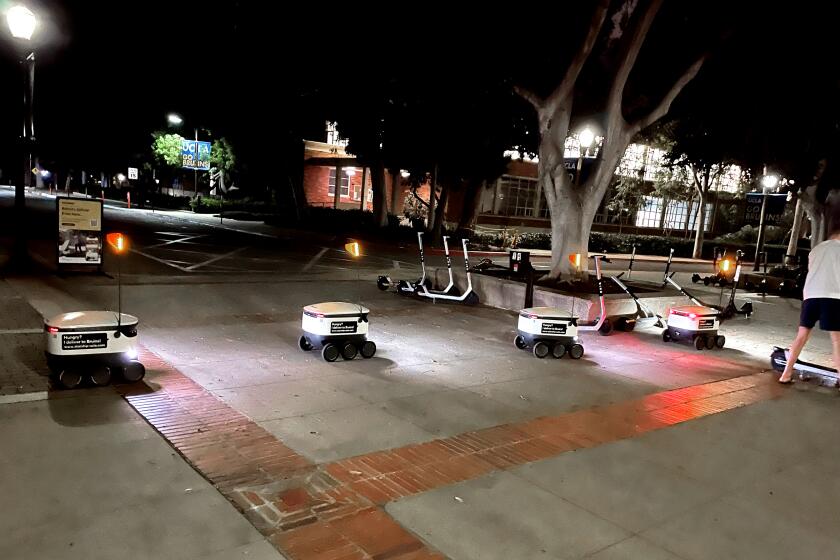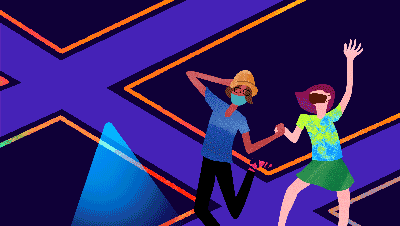
- Share via
On a lightly breezy afternoon, Carlos Shihady and Maram Shehada stood together at the Point Reyes Lighthouse, where the rocky land juts a finger out into the Pacific, and watched “Carlos ❤️ Maram 12 17 2022” appear in the sky.
It was a grand save-the-wedding-date gesture to share with family and friends via social media, marking a high point in a harrowing journey for the couple, long separated by war and pandemic.
With both finally in America together, it had taken more than a month of planning to get to this moment: a squadron of airplanes, so high they couldn’t be seen, forming words with computer-choreographed puffs of vaporized liquid that could be seen for miles.
“The clouds parted in time and I think I was just standing there with her and saying, ‘Oh, my God, look at the writing,’” Shihady said. “It was a special moment for us to announce this date because of all that we went through, you know, with COVID, with Syria.”

A full-on craze in the early days of aeronautics, skywriting faded over the decades. The messages didn’t have the staying power of other forms of advertising, blowing away in the wind, and, at best, were preserved on low-resolution photographs and video that were rarely shared with anyone except immediate friends and family.
But social media and our insatiable promotional hunger have pushed the throttle on the old-timey art form.
Skywriting and other forms of aerial advertising are booming in Southern California, where endless sunny skies create the ideal backdrop to reach a huge audience doing things outdoors or stuck in traffic.
The fleeting images speak of romance, corporate promotions, politics (Donald Trump, for and against, is a favorite subject) and any number of hot-button issues — all shared again and again on social media with the help of smartphones that not only preserve shareable images but can also read hashtags and QR codes floating overhead.
As sidewalk bots proliferate, they turn on the charm — flashing cute eyes, emoji hearts — to keep safe and get deliveries to their intended destinations.
Deep pockets have been launching aerial events for all manner of promo-worthy things: concerts (“Blink-182 IS COMING!” a recent one read), music drops (“TYGA AND DOJA GET FREAKY DEAKY”), products (“CLARITIN CLEAR TODAY”) and movies (“TOP GUN” flanked by pilot’s wings for the sequel). The price tag starts at a few hundred dollars for a plane to pull a banner to a hefty six figures for an elaborately choreographed night drone operation.
The beach during summer is prime aerial advertising territory. Events including Pasadena’s Rose Parade — a national audience saw “AMERICA IS GREAT! TRUMP IS DISGUSTING” one year — and the Super Bowl at Inglewood’s SoFi Stadium have drawn sky displays. A recent video game release party unleashed a 400-drone display in the darkness over downtown Los Angeles.
The business is so niche that research firms don’t produce market reports on it, but practitioners say they’ve never been busier.
Cristina Jacuzzi, who owns an aerial marketing company called Skywriters LLC, brokers jobs for all kinds of aerial advertising, and she said her active client list has grown to more than 165 from fewer than 50 three years ago, many booking multiple jobs during the year. Jacuzzi began specializing in aerial promotion in 2007 but still gets a charge when one of her jobs goes viral.

“When we fly, there’s always tons of pictures that are taken of what we do,” Jacuzzi said. “People just stop what they are doing when they notice it and watch. Then you read their posts about it. ‘Look what I saw today.’ It’s just super cool.”
The coolness factor has been amped up by technology.
Although the single-plane banner-in-the-sky or simple skywritten image is still popular, Jacuzzi said clients, particularly corporate ones, increasingly are willing to pay for the more expensive computer-assisted multiplane version called skytyping — that’s what Shihady and Shehada chose — or vastly more expensive battalions of light-equipped drones beaming their messages through the darkness.
Such technological advancements, enhanced by clever marketing on social media, have elevated aerial promotion to major event status for businesses unveiling products, performers seeking publicity and regular folks trying to create lasting memories, said Lars Perner, assistant professor of clinical marketing at the USC Marshall School of Business.
The social media element “has made this highly symbiotic,” he said, “and there’s a certain kind of elegance and prominence now in having these big displays in the sky.”
You can’t put a price on love, but Amber Kelleher-Andrews has put a price on finding it: $30,000 to $300,000 a year for her elite matchmaking services.
For Shihady and Shehada’s June announcement, Jacuzzi turned to the Skytypers, a family-owned firm that holds a patent on the eponymous form of aerial promotion, in which bursts of smoke (actually biodegradable atomized mineral oil) create images, like a giant flying wireless printer.
The Skytypers hail back to the old biplane days of skywriting, when founder Andy Stinis in 1932 began flying all over the country promoting a little-known beverage company with the simple message “PEPSI” in the heavens. (Stinis’ plane, a 1929 Travel Air D4D, hangs in the Smithsonian National Air and Space Museum’s Stephen F. Udvar-Hazy Center in Chantilly, Va.)
Stinis called his operation the Skywriting Corp. of America, and that’s mainly what he did until he hit on the idea of several planes flying tightly in a row — a difficult formation known as “abreast” in pilots’ lingo — spitting out short bursts of smoke to quickly fashion more complex images that lasted longer and could be seen from greater distances. Stinis got a patent on an image-generating computer program in 1964, and his descendants have kept up the patentable innovations.
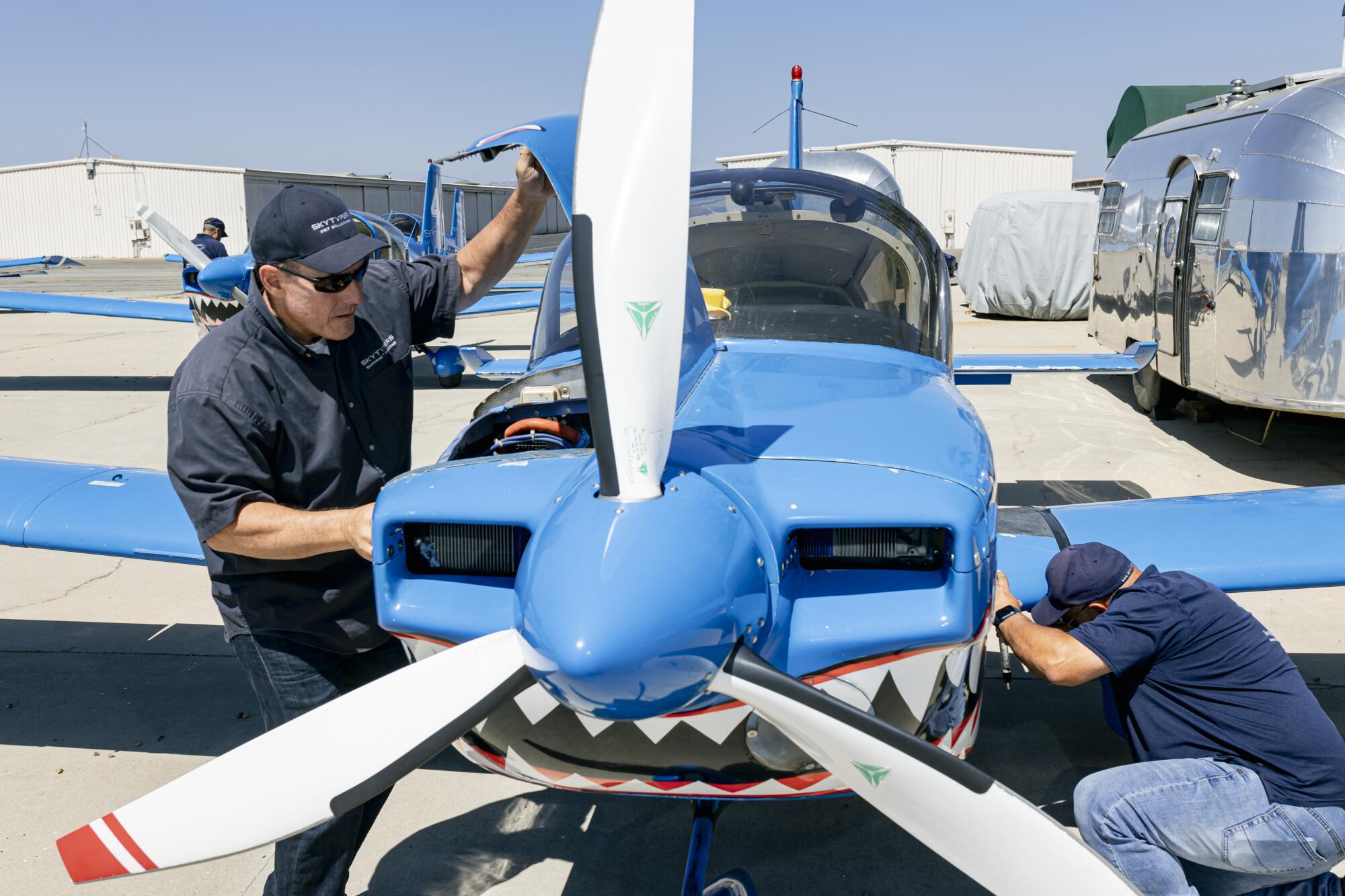
Skytyping is the technological equivalent of moving from handwriting to a wireless dot matrix printer, said Andy’s 48-year-old grandson, Stephen Stinis, who took Skytypers over from his father, Greg.
The company still does banner pulling and skywriting, but skytyping is by far the most requested service, Stinis said.
Skywriting is done with one plane, flying at relatively low altitudes, making complicated aerial moves.
High gasoline prices and concerns about climate change and pollution are pushing some drivers to turn vintage cars into electric vehicles.
If the message is text, the pilot has to remember precisely where the last letter ended because the whole display might have moved if there is a breeze. Even harder is the way the pilot has to fly.
“We call it upside down backwards, which is a mirror image,” Stinis said.
Skytyping takes place 10,000 feet in the air and is visible up to 15 miles away. It’s also quicker than skywriting, just four seconds a character, coming out in a series of puffs. That allows Stinis to complete many more messages in a single day, which is especially valuable during the summer high season.
“We do a line abreast formation,” Stinis said. “We don’t do low passes or rolls together, but we fly together as one unit. It’s a choreography, almost like a ballet, and everything has to be perfect.”
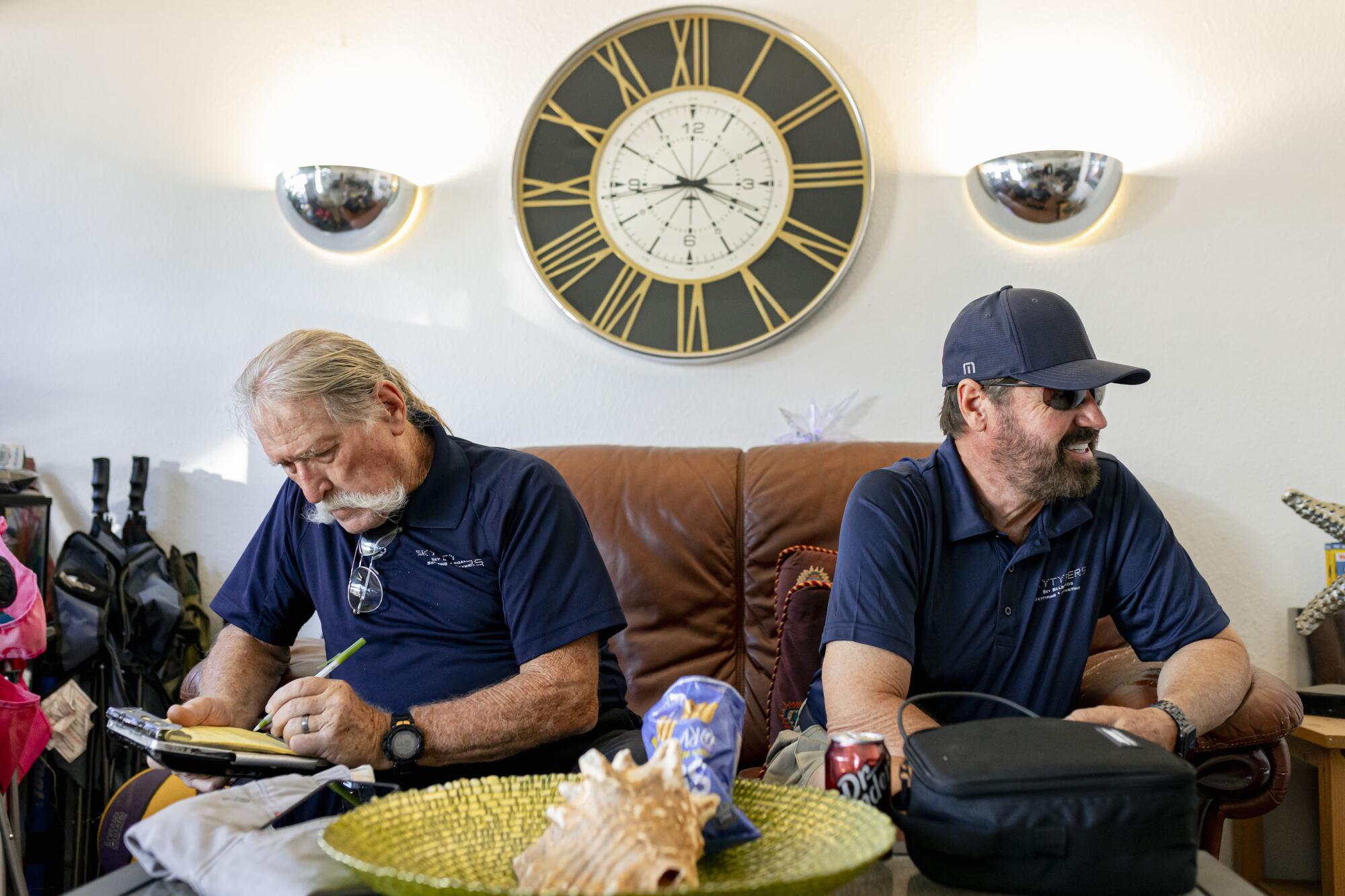
For an “L,” as an example, only one plane lets out puffs of smoke for the base of the letter, while the other four release one puff of smoke to create the letter’s spine. Each letter is as tall as the Empire State Building.
“It’s the largest form of advertising in the world” — in sheer physical size, anyway — Stinis said.
When not flying, Stinis’ planes sit on the tarmac at Chino Airport, tied down with the cockpits covered. They are sturdy and reliable single-prop Grumman American AA-5B Tigers, bright blue with an angry, toothy face stretching around the front of the blue planes, almost to the wings.
Snow wars: Theme parks and malls want artificial snow to draw crowds during the holidays. A growing crew of snow makers work to perfect their secret formulas.
Stinis is loath to have any outsiders working around his business, not even outside mechanics. In fact, even when Stinis is not in the air, he might still be inverted, working on one of his aircraft.
“When you have a business like this, that is demanding on the fly, you can’t rely on other people,” Stinis said. “I take that out of play by doing our own maintenance, especially the smoke systems and everything. They’re all in-house, patented and secret.”
That’s including the software used to coordinate the skytyping in the air, said Stinis, who often flies the lead aircraft. “Usually everything goes automatic through the Wi-Fi,” he said, “and I control everything with real-time messaging I have onboard the lead ship.”
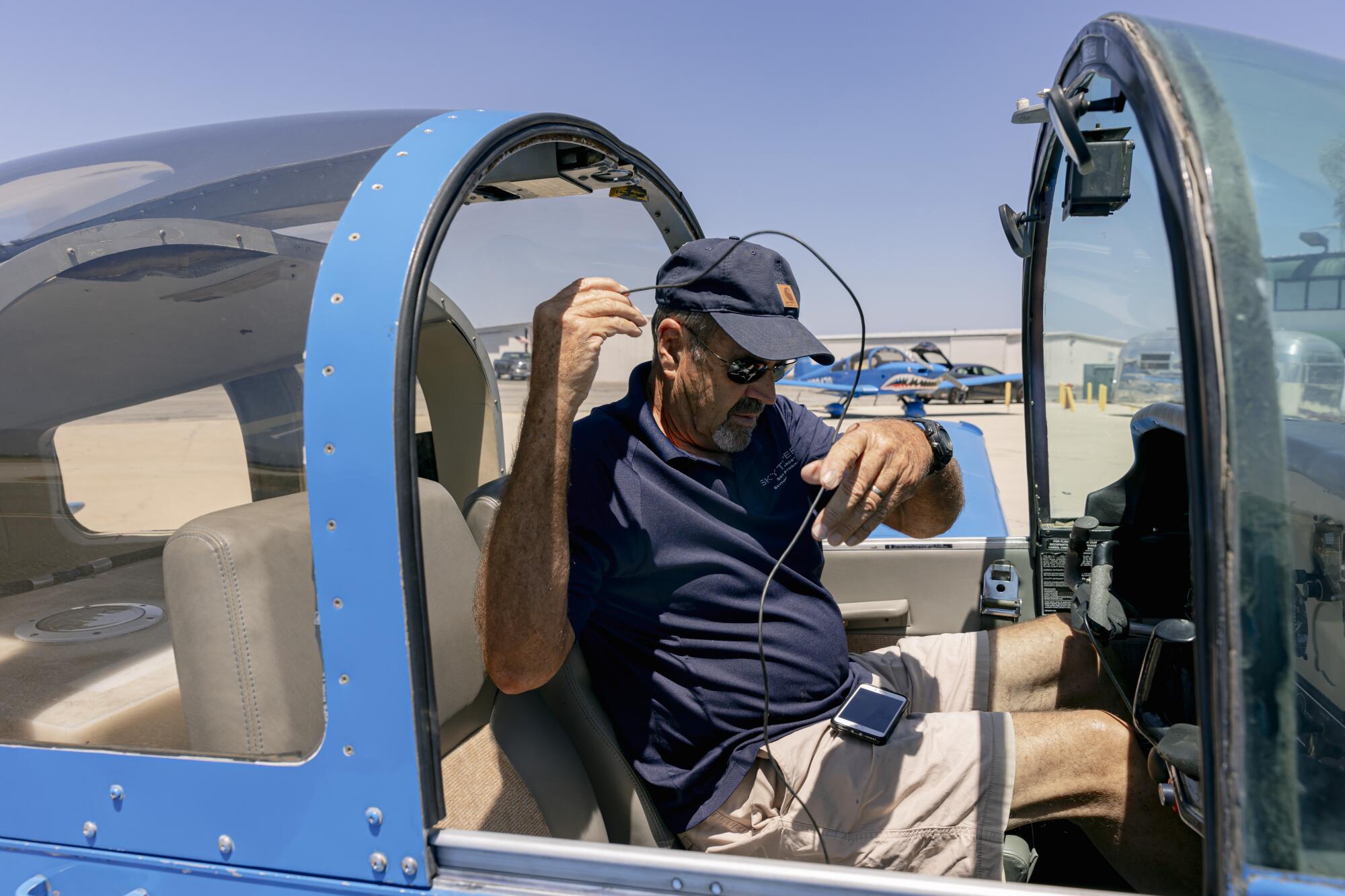
This extreme hands-on approach allows Stinis to control pricing, he said, and maintain a virtual monopoly on the skytyping method. The company, which also operates squadrons out of Las Vegas and North Carolina and licenses its products to others, sends planes pretty much anywhere in the U.S. for gigs.
His company typically charges $17,500 for a package of 10 messages on a single flight, or about $1,750 per message. For a single skytyping message, if the planes are already going to be flying, the charge is typically about $2,500, he said.
It turns out there are jobs aerial marketers won’t take — or at least not without some serious content moderation in advance.
Richard Montañez has for years told a story of how he dreamed up Flamin’ Hot Cheetos while working as a Frito-Lay janitor. The archival record, former employees and Frito-Lay itself say otherwise.
Culture wars have gone airborne with messages for and against political candidates, racial issues, gender rights, immigration, abortion and a wealth of other things society argues about. But Jacuzzi said she doesn’t stand in the way of paying customers with controversial topics to air.
One gig not long ago led viewers to a website with graphic images of aborted fetuses, she said. Jacuzzi also organized an aerial display promoting abortion rights.
Did Jacuzzi really want to get into the abortion debate? “Well, no, but, I’m a messenger, and this is freedom of speech,” she said.
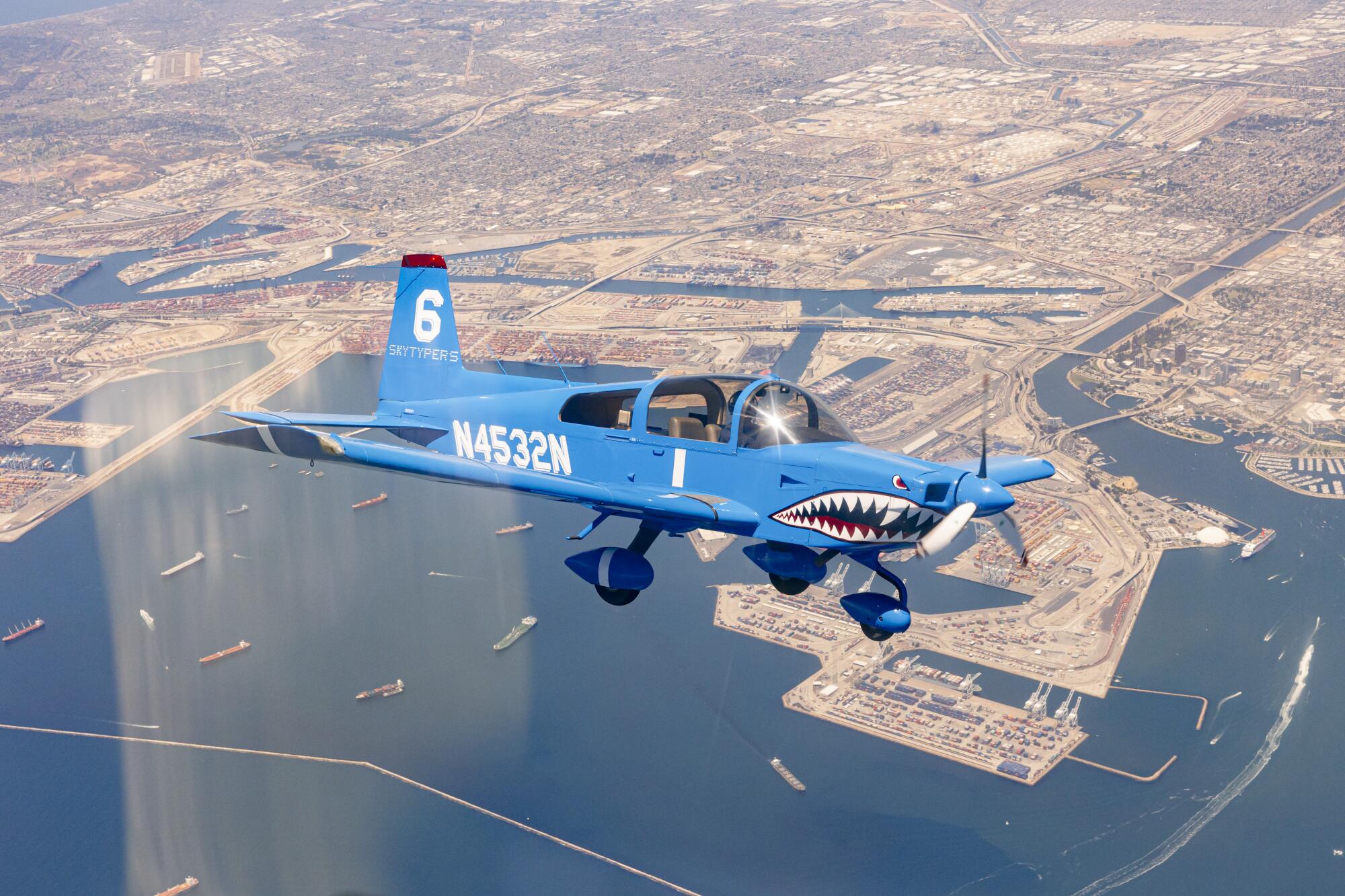
Jacuzzi sees herself as facilitator, brainstorming partner and gatekeeper against anything profane or lewd, lest a passing child look up and be shocked.
One would-be client wanted to set a record for the largest human sexual organ in the sky, over Los Angeles.
“There wasn’t a desert remote enough for me to even consider it,” Jacuzzi said, “much less over Los Angeles.” Stinis, too, flatly refused that request.
The trampoline park industry — once among the fastest-growing franchise businesses in America — can trace its roots to an injury-addled 1960s craze and an extreme sport you’ve never heard of.
There was also a memorial tribute to a musical performer that wasn’t going to take off as planned.
“They wanted do his lyrics, which were all F-bombs,” Jacuzzi said. “And it was like, ‘Yikes, we can’t do the effing this and the effing that. We can’t do this.’ So we had to really tone it down and change it.”
By contrast, a cryptic rap song tease from Eminem and Snoop Dogg reading “DET 2 THE LBC” over Southern California this past summer got quick approval.
A bit of advice is sometimes in order, such as the time an angry wife wanted an aerial expose on her cheating husband flown above his office.
“Talked her out of it,” Jacuzzi said. “I told her to save the money and hire a good attorney.”
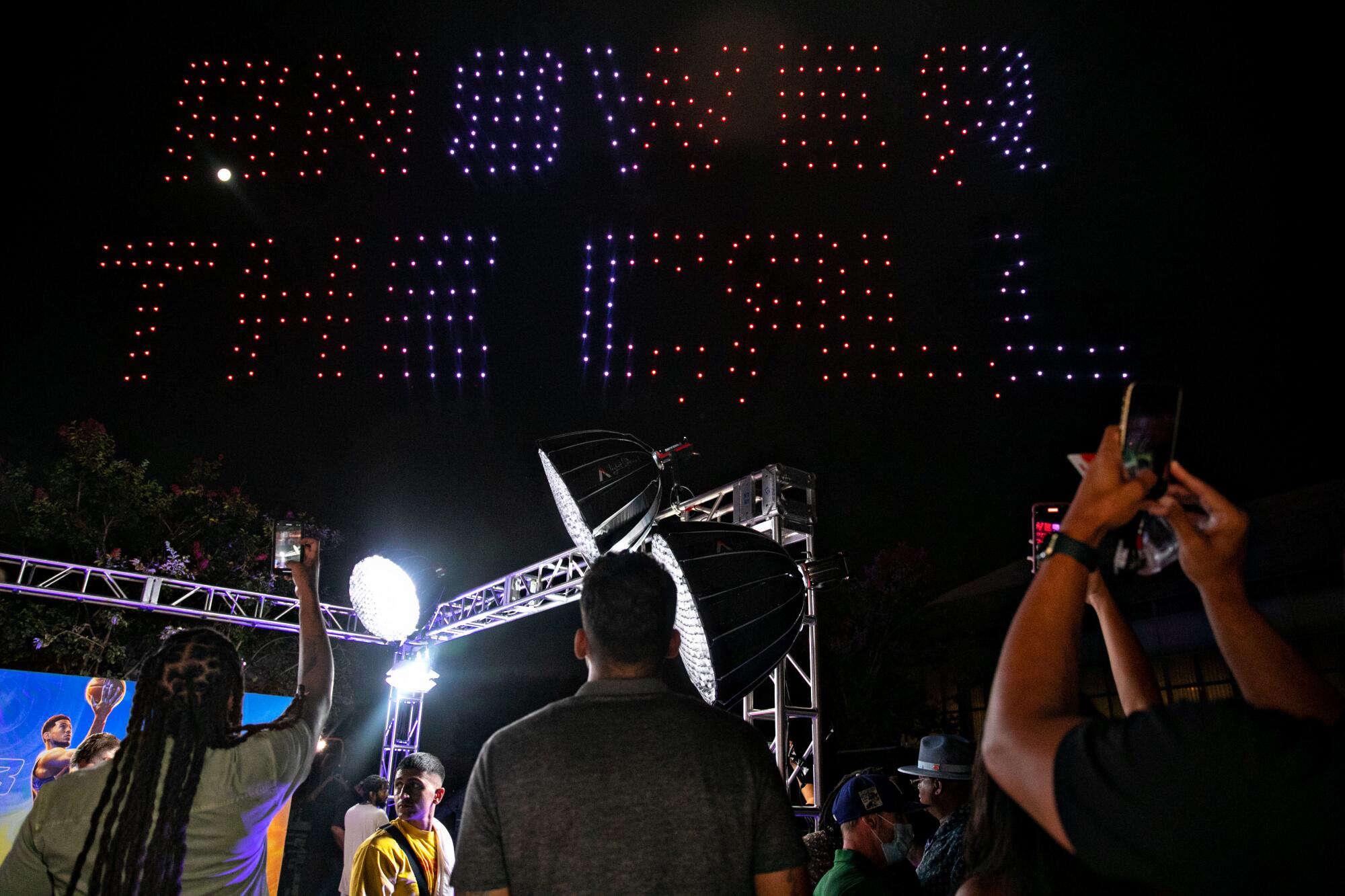
Very little content editing is needed for the most expensive form of aerial marketing, the drone show, because the cost limits the promos to corporations unlikely to request overhead shenanigans. It takes at least 13 drones to create a single letter, Jacuzzi said, and hundreds usually are needed per show, bringing the tab to as high as $250,000.
For the recent release of the “NBA 2K23” basketball video game, which unleashed a 400-drone display over downtown Los Angeles, Jacuzzi turned to Rick Boss, owner of Sky Elements Drone Shows.
To create the images for the celebrity-studded release party, which doubled as a nighttime hovering billboard visible to drivers on nearby freeways, drones small enough to hold in your hand were laid out in rows on an industrial street that had been blocked off for the occasion, Boss said.
Then, directed by a single person with a laptop computer, they assembled in aerial formations so accurate that they can create QR codes readable by smartphones on the ground, Boss said.
For the “2K23” promotion, the drones created more artistic images, including the jersey of recently retired WNBA Seattle Storm star Sue Bird (No. 10) accompanied by the Seattle Space Needle.
“The computer determines their individual paths,” Boss said, “and we synchronize all their clocks and then we send them in the air. Each of them has no idea there’s another drone in the air. They’re just flying their individual missions at their specific time. And our job is to make sure that they don’t bump into each other and that the animation is correct.”
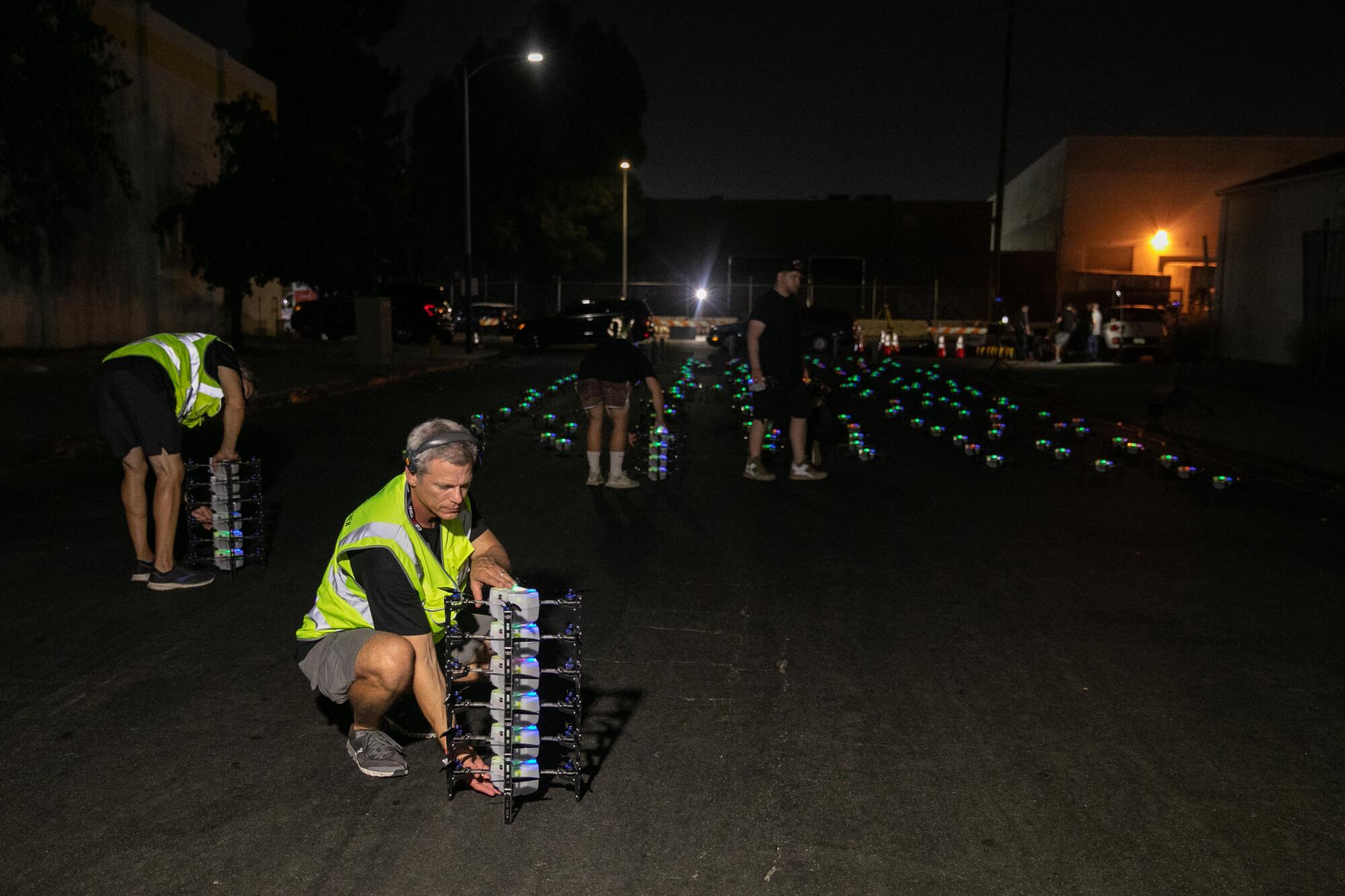
Jacuzzi’s favorite jobs let her hear stories of romance gone right, such as the saga of Shihady and Shehada.
Shihady confessed he spent weeks fretting about the best plans, locations, venues, timing and, of course, the weather. In the end, the stress was worth it.
Seeing it “was a three-minute heart-wrenching rush,” the Lancaster real estate agent said. “It was the most fun thing we have ever done together.”
More to Read
Inside the business of entertainment
The Wide Shot brings you news, analysis and insights on everything from streaming wars to production — and what it all means for the future.
You may occasionally receive promotional content from the Los Angeles Times.
